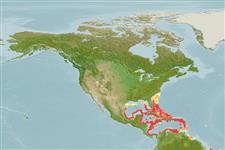Actinopterygii (ray-finned fishes) >
Ophidiiformes (Cusk eels) >
Ophidiidae (Cusk-eels) > Neobythitinae
Etymology: Neobythites: Greek, neos = new + Greek, bythitis, -idos = it is at the bottom, sunken (Ref. 45335); unicolor: From the lack of color markings (Ref. 40522). More on author: Nielsen.
Environment / Climate / Range
Ecology
Marine; benthopelagic; depth range 185 - 935 m (Ref. 34024). Deep-water, preferred ?
Western Atlantic: all over the West Indies except for the southern part of the Caribbean Sea and the main part of the Gulf of Mexico.
Size / Weight / Age
Maturity: Lm ? range ? - ? cm
Max length : 12.6 cm SL male/unsexed; (Ref. 32505)
Short description
Morphology | Morphometrics
Dorsal
soft rays
(total): 97-101;
Anal
soft rays: 82 - 86. Ocelli and vertical and horizontal stripes on fins and body absent. Hind margin of preoperculum with 1 spine. Pseudobranchial filaments 2-3. Teeth granular. Ventral fin rays almost reaching anus, 17-22% SL (Ref. 40522).
Common species (Ref. 34024) found to feed on crustaceans (Ref. 32505). A specimen was caught in a glass sponge Margaritella coeloptyloides at 361 m depth off Cuba (Ref. 32505). Reproductive strategy possibly similar to other members of this family featuring oviparity, with oval pelagic eggs floating in a gelatinous mass (Ref. 205).
Life cycle and mating behavior
Maturity | Reproduction | Spawning | Eggs | Fecundity | Larvae
Nielsen, J.G., D.M. Cohen, D.F. Markle and C.R. Robins, 1999. Ophidiiform fishes of the world (Order Ophidiiformes). An annotated and illustrated catalogue of pearlfishes, cusk-eels, brotulas and other ophidiiform fishes known to date. FAO Fish. Synop. 125(18):178p. Rome: FAO. (Ref. 34024)
IUCN Red List Status (Ref. 115185)
CITES (Ref. 94142)
Not Evaluated
Threat to humans
Harmless
Human uses
More information
Age/SizeGrowthLength-weightLength-lengthLength-frequenciesMorphometricsMorphologyLarvaeLarval dynamicsRecruitmentAbundance
ReferencesAquacultureAquaculture profileStrainsGeneticsAllele frequenciesHeritabilityDiseasesProcessingMass conversion
Tools
Special reports
Download XML
Internet sources
Estimates of some properties based on models
Phylogenetic diversity index (Ref.
82805): PD
50 = 0.5000 [Uniqueness, from 0.5 = low to 2.0 = high].
Bayesian length-weight: a=0.00407 (0.00156 - 0.01061), b=3.12 (2.90 - 3.34), in cm Total Length, based on LWR estimates for this (Sub)family-body shape (Ref.
93245).
Trophic Level (Ref.
69278): 3.5 ±0.50 se; Based on food items.
Resilience (Ref.
69278): High, minimum population doubling time less than 15 months (Preliminary K or Fecundity.).
Vulnerability (Ref.
59153): Low vulnerability (16 of 100) .
